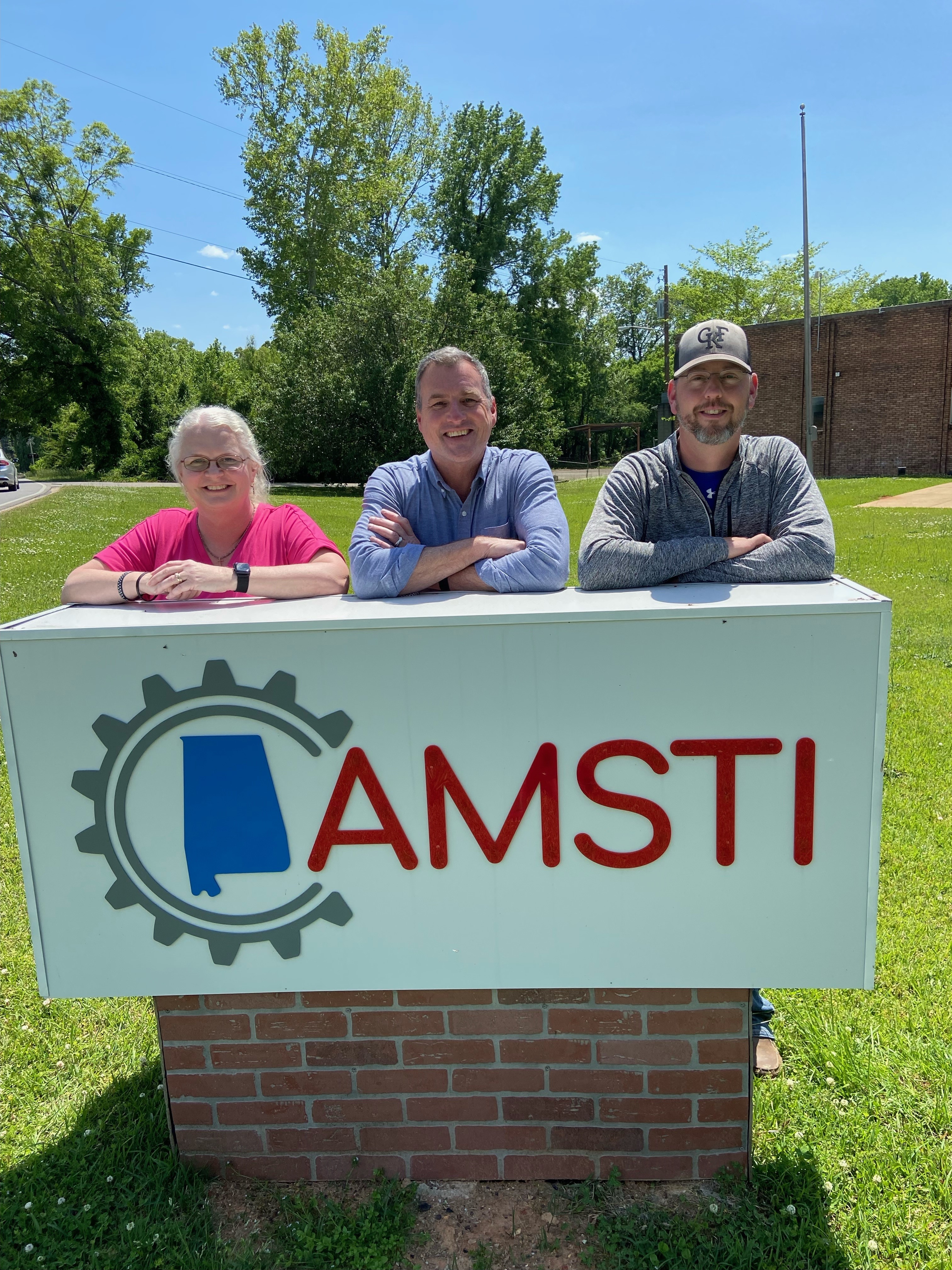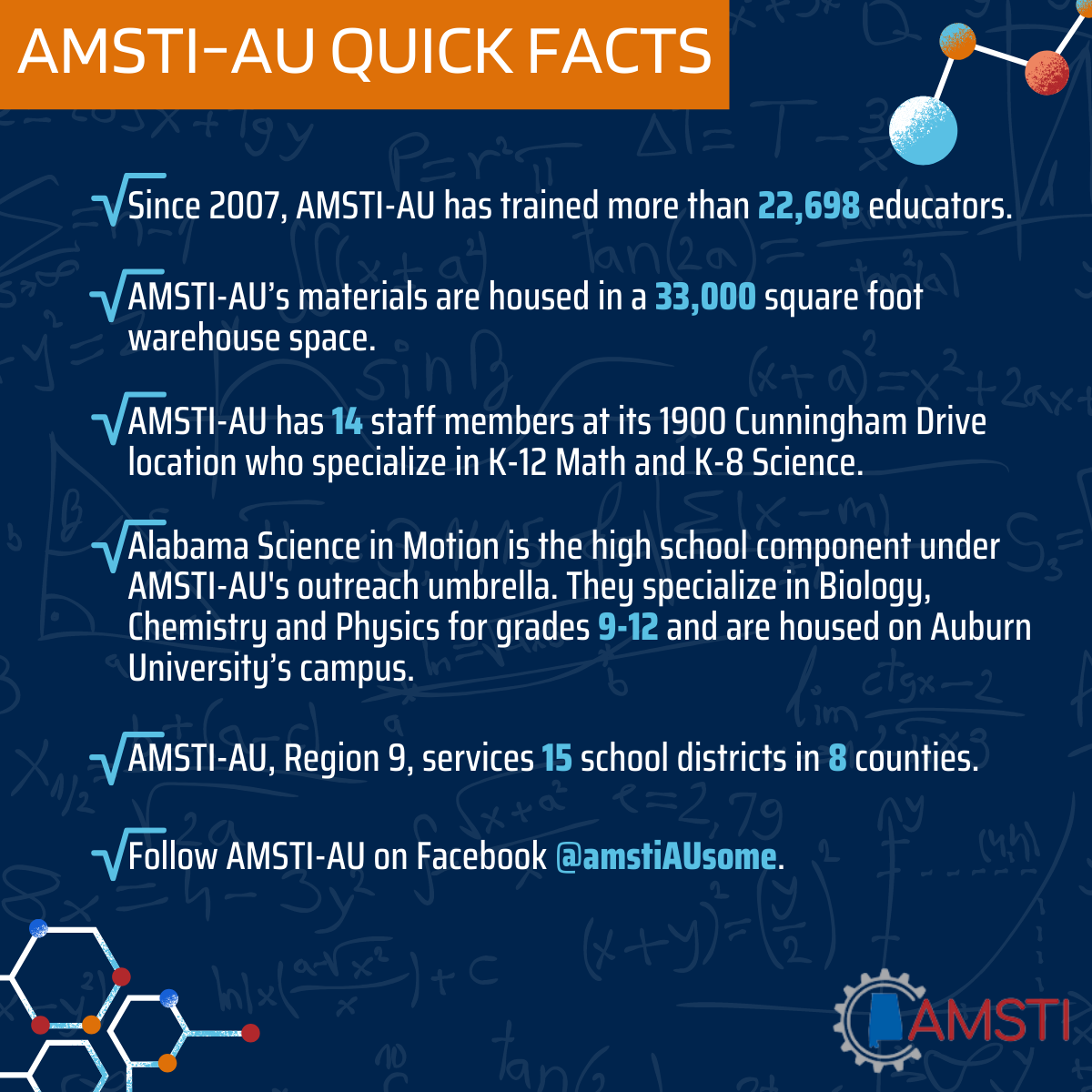COSAM News Articles 2022 May AMSTI-AU Spotlight: meet the original staff improving STEM instruction and empowering educators across the state
AMSTI-AU Spotlight: meet the original staff improving STEM instruction and empowering educators across the state
STEM outreach has evolved quite a bit since 2007 when Joel Hill, Kristy Mann and Wayne Strickland began their roles at Auburn University’s newly-formed regional site with the Alabama Math, Science and Technology Initiative, or AMSTI.
Presently, what hasn’t changed is Hill, Mann and Strickland’s dedication to carrying out AMSTI’s mission of providing impactful STEM instruction and resources that empower educators and students across the state.
AMSTI is the Alabama Department of Education’s initiative to improve STEM teaching statewide. Its objective is to support Alabama educators and students in learning STEM through doing STEM, with the premise that students learn math and science best by doing math and science, especially when they are able to relate it to their daily lives.
AMSTI specialists provide virtual and in-person professional learning opportunities for educators, instructional resources and materials, and onsite educator support in 11 regional sites throughout Alabama.
Hill, Mann and Strickland are three original staff members, along with former director Beth Hickman who has since retired, who started in May 2007 when AMSTI established its Region 9 site at Auburn University, known as AMSTI-AU. Region 9 serves 15 school districts located in Barbour, Bullock, Chambers, Elmore, Lee, Macon, Russell and Tallapoosa counties. AMSTI-AU is an outreach program in the College of Sciences and Mathematics, or COSAM.
Hill initially came to AMSTI from a position in the banking industry to oversee AMSTI-AU’s warehouse and materials.
“I started working part-time in the evenings in March 2007 to get things prepared before our site officially launched,” said Hill. “At that time, AMSTI-AU’s offices were housed among separate storefronts and warehouses at 480 North Dean Road. Our original warehouses were each around 1,500 square feet - now we’re in 33,000 square feet of warehouse space in our current location at 1900 Cunningham Drive.”
Hill’s role has expanded in scope, and he now serves as AMSTI-AU’s business manager and professional development, or PD, coordinator. As business manager, he manages the warehouse - including ordering supplies, overseeing packing kits and arranging material pick-ups with schools - and manages the budget and state-allocated funds alongside AMSTI-AU director Pam Norris. As professional development coordinator, he assists AMSTI specialists with setting up PD trainings, prepares PD reports for the state, and oversees their PowerSchool system to ensure educators get PD credit for attending trainings which supports educator recertification.
Mann initially came to AMSTI directly from the classroom, noting she finished teaching on a Friday and started AMSTI on a Monday.
She currently serves as an AMSTI math specialist for grades 6-12.
“Our other 6-12 math specialist, Brad Estes, and I split up the schools in our region and we each serve half,” said Mann. “In my role, I travel to schools and provide onsite classroom instructional support to educators, and I provide virtual and in-person professional learning opportunities to teachers. One aspect of my job that has evolved over time is that now I also provide coaching to math teachers and math coaches.”
Strickland, like Mann, came to AMSTI straight from his classroom. His first week at AMSTI, he remembers starting with empty offices, building their own furniture and starting from the ground up.
There is no typical day in his current role as an AMSTI science specialist for grades 3-5, and his role’s main focus, like Mann’s, is working with classroom educators to support them by providing educational materials and training.
“One day, I might be training educators on a particular science unit, assessments or classroom management,” said Strickland. “The next day might involve working with AMSTI staff and school administrators to plan logistics for educator events like our upcoming summer institute. I’ll also be traveling soon to train teachers who will be brought in as AMSTI trainers.”
As a state education initiative, AMSTI’s instructional guidelines and materials continue to evolve over time, particularly when state education standards are adjusted. AMSTI’s instructional model had to shift to provide virtual-based instruction, support and PD opportunities during the pandemic, COVID-19 – a shift which resulted in better ways to provide technology in the classrooms.
“One common request that we’re seeing from educators now is how they can use technology to enhance their classrooms,” said Mann. “In 2007, physical graphing calculators might have been the only form of technology utilized in math classrooms. Now, we use a free online graphing calculator called Desmos, so more educators and students can have access to technology.”
“We use math and science journaling in the classroom and have typically utilized physical composition notebooks,” said Strickland. “If a student is out for an extended period, a paper notebook in the classroom makes it difficult to remain consistent with keeping a portfolio of their learning. AMSTI has developed digital science notebooks that can be accessed on a platform from any location, so that students can still maintain their portfolio.”
While AMSTI specialists have been eager to get back to effective in-person instruction and support, Mann noted that the continued use of technology has made it practical for reaching larger numbers of students.
“Before students took the Alabama Comprehensive Assessment Program, or ACAP, this spring, AMSTI offered student experiences to help prepare them for the assessment,” said Mann. “Brad and I offered these via Zoom, and we ended up training around 10,000 students within a three-day span. That was a great way we’ve seen technology utilized as a resourceful, time management tool.”
This summer, AMSTI is offering numerous math virtual trainings at the state level. For Region 9, a comprehensive listing of AMSTI-AU’s K-12 math and science training offerings can be found here.
For more information on AMSTI-AU, follow them @amstiAUsome on Facebook or contact AMSTI-AU Director Pam Norris at pwn0001@auburn.edu.
Latest Headlines
-
07/09/2024
-
Summer Bridge Program celebrates 21 incoming Auburn students as they prepare for future STEM careers07/02/2024
-
07/02/2024
-
06/17/2024
-
06/07/2024


